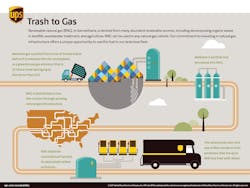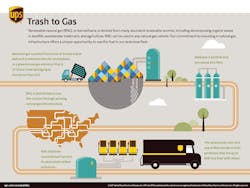Infographic: From trash to natural gas
UPS plans to invest $90 million in more compressed natural gas stations and vehicles. The company created this infographic to show renewable fuels powers some of the UPS fleet of brown trucks and vans.
Renewable natural gas (RNG), or biomethane, is derived from many abundant renewable sources, including decomposing organic waste in landfills, wastewater treatment, and agriculture. RNG can be used in any natural gas vehicle. UPS says its commitment to investing in natural gas infrastructure offers an opportunity to use this fuel in its extensive fleet.
1. Methane gas is pulled from acres of buried waste before it is released into the atmosphere as a greenhouse gas emission that is 25 times more damaging to the ozone than CO2.
2. RNG is distributed across the country through existing natural gas infrastructure.
3. Methane is purified and processed into RNG.
4. RNG displaces conventional fuel and its associated carbon emissions.
5. The total production and use of RNG results in GHG emissions that are up to 90% less than with diesel.

